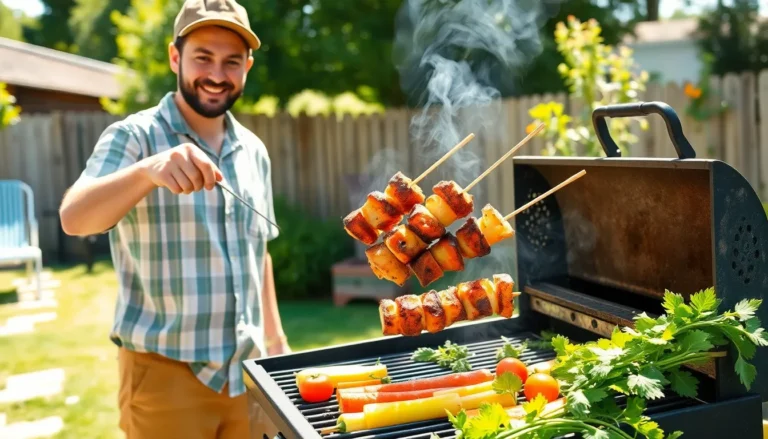Table of Contents
ToggleWhen it comes to defining your property, a good fence isn’t just a boundary—it’s a statement. Whether it’s keeping the neighbor’s overly friendly dog at bay or ensuring the kids don’t turn the yard into a makeshift race track, choosing the right fence can make all the difference. With so many options available, it’s easy to feel like a kid in a candy store, but don’t let the choices overwhelm you.
From charming picket fences that scream “welcome” to sturdy livestock fences that could withstand a stampede, each type serves its purpose and adds character to your home, barn, or shed. So, before you start picturing a fence that’s a cross between a medieval fortress and a modern art installation, let’s explore the most common types of fences that can keep your space secure while still looking fabulous.
Overview of Common Fence Types
Choosing the right fence type plays a crucial role in enhancing a property’s functionality and aesthetics. Many homeowners opt for picket fences due to their classic charm. These fences often feature evenly spaced vertical boards, creating an inviting entrance while defining the property line.
For greater privacy, privacy fences serve as a popular choice. Made from solid panels or closely spaced boards, these fences block views from outside and offer a secure environment. They typically reach heights of six feet or more, making them ideal for backyards.
Chain link fences offer a practical solution for those seeking security without obstructing visibility. Often seen around commercial properties, these fences consist of woven metal wire and can deter unwanted visitors. They’re low-maintenance and budget-friendly, appealing for both residential and agricultural use.
Wire fences come in various styles, including barbed wire and field fencing. Barbed wire is common for livestock containment, while field fencing is often used for gardens and crops. These options provide durability and flexibility, especially on larger farms.
Homeowners in rural areas frequently turn to wooden post and rail fences. These fences consist of horizontal rails secured to vertical posts, blending rustic charm with functionality. They effectively contain livestock while adding character to landscapes.
Vinyl fences are rising in popularity due to their low upkeep and resistance to weathering. Available in various designs and colors, they replicate the appearance of traditional wood without the associated maintenance challenges. Sustainability and longevity rank high among reasons for choosing vinyl.
Exploring these common fence types allows homeowners to select the option that best meets their needs. Each type carries unique benefits and adapts to different requirements, ensuring suitability for various properties.
Fences for Residential Homes
Various types of fences enhance residential properties, providing both functionality and aesthetic appeal. Homeowners often choose fences based on their needs and preferences.
Privacy Fences
Privacy fences offer seclusion in various residential settings. Solid panels or tall designs effectively shield yards from view, making them ideal for those seeking peace. Common materials include wood, vinyl, and composite options, each providing distinct benefits. Wood fences present a natural appearance, while vinyl fences require minimal maintenance. Many homeowners select heights of six to eight feet for optimal privacy. Enhanced security comes with privacy features, discouraging unwanted access to backyards.
Decorative Fences
Decorative fences contribute charm and personality to homes. Picket and wrought iron designs stand out for their visual appeal and classic styles. Picket fences create a welcoming atmosphere, often painted in bright colors. Wrought iron fences convey elegance, perfectly framing gardens or walkways. Homeowners also explore options like bamboo or lattice for unique aesthetics. Besides beauty, decorative fences can define boundaries and enhance curb appeal. Each type serves its purpose while complementing landscaping and architectural styles.
Fences for Barns
Fences play a critical role in barn environments, protecting livestock and providing clear boundaries. Several types exist, each designed to address specific needs.
Stock Fencing
Stock fencing stands as a robust option for containing livestock. This type typically consists of wire stretched between wooden posts, creating a strong barrier that discourages animals from escaping. Galvanized wire resists rust and wear, enhancing durability. Many choose barbed wire variants for additional security, preventing animal tampering. Height usually ranges from four to five feet, suitable for most farm animals. It effectively keeps livestock in while ensuring they remain safe from external threats.
Horse Fencing
Horse fencing requires careful consideration due to the unique needs of equines. Ideal choices include vinyl and wooden board fences, which provide visibility and safety. Height often exceeds five feet, preventing horses from jumping over. Smooth surfaces mitigate injury risks, while designs incorporate features to minimize toe grabs. Many horse owners appreciate electric fencing as a supplemental barrier, delivering a gentle deterrent without causing harm. Selecting the right fencing ensures the well-being of horses while maintaining an attractive barn aesthetic.
Fences for Sheds
Fencing around sheds provides both security and organization. Different types of fences suit varied needs.
Security Fencing
Security fencing enhances protection for sheds, ensuring valuable tools and equipment remain safe. Chain link fencing stands out with its durability and visibility. It allows monitoring while deterring potential intruders. Alternatives like welded wire fencing offer strength, making it difficult for unauthorized access. Electric fencing, though less common, serves as a strong deterrent, particularly for larger properties. Strong materials resist damage and harsh weather conditions, extending the fence’s lifespan. Installing security fencing around sheds typically ranges from four to six feet in height, balancing visibility and security effectively.
Garden Fencing
Garden fencing adds charm while keeping areas organized. Wooden picket fences create a quaint look, enhancing aesthetic appeal alongside garden beds. For greater privacy and protection, solid wood or vinyl fences provide enclosure. These options prevent wildlife from entering and causing damage while keeping pets contained. Decorative wire fencing maintains a light, open feel, allowing sunlight and air circulation while defining garden spaces. Height often varies between three to four feet, perfect for ornamental purposes. Each type serves to enhance the shed’s environment while complementing the overall landscape.
Choosing the right fence is essential for any property owner. It not only defines boundaries but also enhances the overall aesthetics and functionality of the space. Whether it’s the classic charm of a picket fence or the robust security of barbed wire, each type serves a unique purpose tailored to specific needs.
Homeowners should consider their priorities, whether it’s privacy, security, or visual appeal. For barns and sheds, the focus shifts to durability and livestock protection. With various options available, it’s possible to find a fence that complements the character of the property while fulfilling practical requirements. Ultimately, the right fence can enhance both the beauty and value of any home or agricultural setting.





